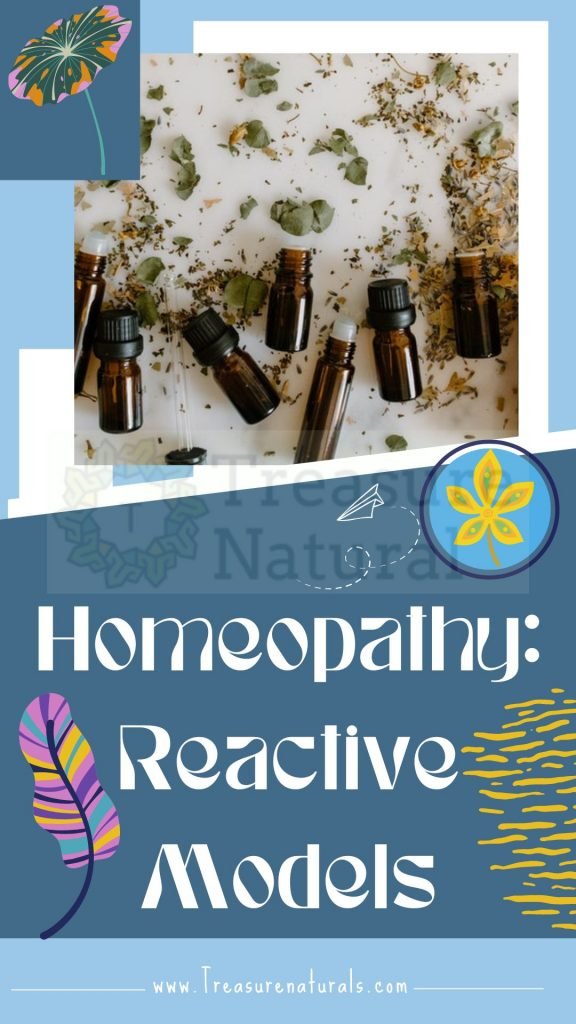
Homeopathic Medicine is based on the so-called “principle of similarity”, of Galilean memory, according to which the parallelism of action between experimental power and therapeutic power of a substance is established. The Reactive Model is a valuable tool for homeopathic diagnosis and therapy.
The concept of reactive model is introduced by Christian Friederich Samuel Hahnemann (1755-1843), the father of Homeopathy, after many years of studies on healthy man and is an evolution of the initial concept of diathesis or the predisposition to illness linked to family or genetic factors of the individual.
Homeopathic Medicine, as known, is based on the so-called “principle of similarity“, of Galilean memory, on the basis of which the parallelism of action between experimental power and therapeutic power of a substance is established. Wanting to schematize the fundamentals of Homeopathy we can summarize them as follows:
- Each pharmacologically active substance or remedy is capable of producing a clinical picture characteristic of the substance used.
- Each patient presents a characteristic clinical picture of his reactivity against a noxa or morbid pathology.
- Healing is achieved with the administration, at weak or infinitesimal doses, of the substance that has been shown experimentally capable of producing a clinical picture similar to the one to be treated.
An example of this is the use of Apis mellifica in dermatological pathologies, which present the pomfo as an elementary lesion, which corresponds to the power of bee venom to create similar lesions. Even in chronic cases, the basic concept of Homeopathy applies, that the prescription is carried out following the “principle of similarity”, but this is not limited to the current symptoms, but is extended to the concomitant symptoms and above all to the morbid antecedents of the patient.
In addition, ample consideration is given to data on biotypology, i.e. the typological characteristics of the subject and among these data, the reactive models are of particular importance, i.e. the methods of response that the body has towards morbid stresses. The reactive models described are four and each corresponds to a “pharmacological family”, or a certain number of substances or remedies able to counteract their pathogenic action and therefore to treat the pathological noxa. Below are the characteristics and remedies of the main homeopathic reactive models:
Psoric Reactive Model
Tuberculin Reactive Model
Sycotic Reactive Model
Reactive Model Luesinico
Psoric Reactive Model
It is the chronic disease that Hahnemann considered as the most widespread, due to the consequences of “scabies“, a very common parasitosis in his time, which incorporated not only the sarcoptic scabies itself (sarcoptes scabei), but also all dry or oozing skin diseases, having intense itching, aggravated by the heat of the bed and water, improved by the cool.
The origin of the psora was, therefore, first linked to scabies and the lack of hygiene of the times, then a century later, it came, by the Swiss Antoine Nebel (1870-1954), connected to the infection of Koch’s bacillus (Mycobacterium tubercolosis), for the great spread of tuberculosis at the beginning of the twentieth century. In our days this disease can be considered a pathology of adaptation and therefore a global reactive model, probably with a genetic component.
The Psoric Reactive Model can thus be defined as the tendency to react by alternating skin manifestations with internal diseases that evolve by crisis, such as certain allergic diseases and many metabolic disorders. The triggers of this reactive model, which like others rests on genetic factors, seem to be sedentariness and hygienic-dietary errors, which are typical of urban civilization. The fundamental characteristics of the Psoric Reactive Model can be summarized in:
- Alternation of symptoms between them
- Periodicity of morbid manifestations
- Preferential skin tropism
- Frequent parasitosis
- Arterial congestion
- Acute diseases with abrupt onset, seizure defervescence, rapid convalescence.
- Improvement with the elimination of physiological or pathological fluids.
- Tendency to metabolic overloads (hyperdislipidemia, hyperuricemia, hyperglycemia).
- Psychological tendencies extroversion, one related to the tendential “pathological expressiveness”: everything that runs with psoric mode is clear and externalized.
Characteristic Remedies of the Psoric Reactive Model
- SULFUR
- CARBONIC LIMESTONE
- LYCOPODIUM
- ARSENICUM ALBUM
- PSORINUM
The “polycresto” remedy or remedy with a wide action in the psoric group is certainly SULFUR, the homeopathic preparation is obtained by shredding and subsequent dilution in hydroalcoholic solution of sulfur crystals (sulfur). Sulfur is a largely present in nature, but its indispensable and essential role is played from a biological point of view, as a catalyst or accelerator element of cellular and extracellular biochemical reactions.
In the human body, where it makes up 0.25% of the total mass, it is present in all cells and in many proteins, in some B vitamins and is also present in many organs such as liver, connective tissue and pancreas linked to the production of insulin. It also performs important functions at the immunological, neurological, pulmonary, renal and musculoskeletal levels.
From the homeopathic point of view this remedy adapts to all Constitutions, but it is in particular the Sulfurica, which best responds to the characteristics of the medicine, this, in fact, acts on the symptoms at the level of the skin, mucous membranes, serous tissue, connective tissue, blood circulation and liver.
The main hallmarks of SULFUR are:
- Burning sensation at various levels (soles of the feet, top of the head, etc.)
- Feeling of warmth
- Itching worsened by bed heat or wool
- Worsened symptoms: in the heat in general, at 11 am, standing
- Periodicity of symptoms (every 7 or 14 days)
- Redness of the orefizi (eyelids, ear, nose etc.)
- Irritating secretions
- Desire for sweet foods, alcoholic beverages, spicy foods
- Urgent diarrhea (at night or early in the morning)
- Irritating and fetid sweating (armpits and genitals)
- Fever with intense thirst, dry and burning skin
The indications of the SULFUR remedy of the psoric group are many, thanks to its vastness of action, it is counted both in acute and chronic pathologies:
- Continuous or remitting acute febrile states
- acute forms: exanthematous fevers, acute inflammations in general, chronic dermatoses
- chronic skin forms: atopic or contact eczema, herpes, furunculosis and pustular acne, respiratory allergies (coriza and asthma)
- chronic respiratory forms: chronic rhinitis, chronic bonchitis, stomatitis, canker sores, gastritis
- chronic forms of the digestive system, heptic congestion, hepatodigestive hemicaneous, colitis and enterocolitis, arthralgia of various degrees (upper limbs and knees)
- chronic joint forms, low back pain (worsen by getting up), pelvispondylitis
- chronic cardiovascular forms: arterial hypertension (early stages), left ventricular failure, nocturnal incontinence of the child
- genitourinary forms, chronic cystitis and prostatism, vaginitis
- endocrine forms, diabetes
Tuberculin Reactive Model
This is a reactive mode called “tuberculin“ subgroup of the psoric reactive mode, which describes individuals having in their pathology a psoric reactive model, with a particular type, are rather thin subjects, despite a well-preserved appetite, cold or hypersensitive to the cold with frequent affections of the upper respiratory tract; nervous , sensitive, irritable. The key features of the subgroup are:
- Variability of symptoms
- Fatigue and asthenia
- Neurodystonia
- Catarrhal inflammation of the upper airways
- Demineralization
- Increased catabolic metabolism
Characteristic Remedies of the Tuberculin Reactive Model
- PHOSPHORUS
- PHOSPHORIC LIMESTONE
- PHOSPHORICUM ACIDUM
- PULSATILLA
- NATRUM MURIATICUM
- SILICEOUS
- SULFUR IODATUM
- TUBERCULINUM
The characteristic remedy of the tuberculin group is PHOSPHORUS or white phosphorus, a strongly reducing elemental substance, it is a metalloid and comes in the form of colorless or yellowish-white crystals, which in homeopathic preparations undergo a heating to 70 ° in alcohol and subsequent dilutions. This constitutional medicine has a sensitive type, both in adults and in children, with a tendency to fatigue, hypersensitivity to environmental stimuli, hemorrhages, in the presence of anxiety and depression. The distinctive and characteristic signs of Phosphorus can be summarized as follows:
- sensory hyperesthesia (noise, light, smells)
- Psycho-behavioral alterations: alternation of phases of excitement, euphoria and excessive affectivity with depression, abulia and apathy
- Psychoasthenia and excessive fatigue
- Hemorrhagic diathesis
- Burning sensation ( palms hands, along the spine)
- Desire for cold or iced food and drinks
- Insatiable hunger at night
The main clinical indications of the remedy Phosphorus, of the tuberculin group are:
in acute manifestations:
- Frequent bleeding and their prevention
- Acute pneumopathies
- Hepatitis
- Laryngitis
- Infant gastroenteritis
- Severe acetonemic vomiting
- Acute pancreatitis
- Acute hematuric nephritis
in chronic manifestations:
- Chronic alcoholism
- Chronic liver disease (liver failure, cholecystitis)
- Atherosclerosis and Heart Failure
- Chronic renal failure
- Vascular complications of diabetes
- neurological indications (myelitis, polyneuritis)
other indications:
- Behavioral disorders (excitement – depression – Hypersensitivity etc.)
Sycotic Reactive Model
The name of this reactive model originates from the Greek term σύκωσις which means sycoma or fig tumor as Hahnemann intended, nothing to do, therefore, with the dermatologicalterm that indicatesan inflammation of the hair follicles. The sycotic reactive model finds its origin in an imbalance of the immune system due to the action of multiple immunosuppressive factors such as: incongruous antibiotic therapies in the course of viral diseases or in inadequate doses or in insufficient times, with the result of creating a selection of resistant bacteria; or corticosteroids administered for a long time and treatments with immunosuppressive drugs; prolonged or poorly treated infections, appropriately repeated vaccinations; depressions cured for a long time with psychiatric drugs. Distinctive features of the Sycotic Reactive Model are:
- Evolution of subtle and slow diseases with progression of affections
- Water retention with tissue imbibition
- Chronic catarrhal infections of the genital tract and upper respiratory tract
- Formation of skin growths, cysts, benign tumors
- Lymphatic congestion
- Constant physical asthenia Aggravation with moisture
- Involvement of peri-articular tissues, with joint stiffness
- Difficulty in adapting to the environment, to social rhythms
Characteristic Remedies of the Sycotic Reactive Model
- THUYA OCCIDENTALIS
- NATRUM SULFURICUM
- CAUSTICUM
- MEDORRHINUM
The key medicinal product of the sycotic group is THUYA OCCIDENTALIS, a plant of the Cupressaceae family, also called “tree of life”,it is particularly widespread in Canada and North America and in Europe where it is cultivated for ornamental purposes. The Mother Tincture, obtained from spring twigs, contains mainly: Tannin (5%), Flavonoids and essential oils. Its main action is carried out on the genitourinary organs, on the skin, on the lymphatic system and on the nervous system. The sensitive type, which responds well to the remedy is classically described as a subject “coated” or fat or infiltrated into the torso with slender legs, oily and greasy skin, with the presence of warts and striated nails. The salient characteristic signs of the medicine are:
- Unbearable neuralgia
- Cenesthesias of various kinds: sensation of foreign body in the belly or bone fragility
- Worsened by cold and humidity
- Worsening at 3 a.m. or around 3 p.m.
- Worsening after vaccinations or drug treatments
- Characteristic yellow-greenish secretions
- Foul-smelling sweats
- Borborigmi and abdominal noises
- Fixed ideas
- Depression
The main clinical indications of Thuya as a remedy of the sycotic group are:
- Pathologies resulting from vaccinations, antibiotic therapies, use of oral contraceptives etc.
- Nasopharyngitis, relapsing bronchitis
- Tonsillar hypertrophy or adenoids or nasal polyps
- Delayed allergies: asthma, eczema
- Genitourinary pathologies: prostatic hypertrophy, bladder polyps, leucorrhoea, recurrent urinary infections
- Skin indications: warts, papillomas, HPV warts, juvenile acne, boils, cellulitis
- Nervous pathologies: neuralgia, cenesthesia, reactive depressions.
Reactive Luesinic or Syphilitic Model
The term Luesinico properly refers to the venereal disease called Lue or Syphilis, due to the infection with Treponema pallidum, which was attributed by Hahnemann for the analogy between this disease and the medicine then used to treat it, namely the mercurius, both, in fact, caused irritation, ulceration and sclerosis ; over time, other distinctive features such as alcoholism were added. The main features of the Luesinic Reactive Model can be summarized as follows: . Psychic instability and constant need for change . Phobias of disease, contagion or death. Tendency to ulceration and sclerosis . Hyperkeratosis and tendency to cracking of skin lesions . Lymphadenopathy with lymph nodes of wooden consistency . Nocturnal aggravation of symptoms
Characteristic Remedies of the Luesinico Reactive Model
- MERCURIUS SOLUBILIS
- FLUORIC LIMESTONE
- FLUORICUM ACIDUM
- ARGENTUM NITRICUM
- AURUM METALLICUM
- LUESINUM
- PLATINA
- PLUMBUM METALLICUM
The most representative remedy of the luesinic group is MERCURIUS SOLUBILIS or “Hahnemann’s soluble mercury“,which is obtained from a mixture of mercury (Hg) compounds after filtration and precipitation. The final product contains 85% Hg and has an action on inflammation of the ENT, ophthalmic, respiratory mucous membranes, on skin or bone suppurations, on neurological disorders. The characteristic signs of the medicine are mainly:
- Metallic taste
- Tingling in the lips
- General weakness with serotine chills
- Cranial and tibial periostatal pain
- Tenesmus and genitourinary or rectal burning
- Worsening of symptoms at night
- Improves with dry weather
- Purulent, irritating secretions of various apparatuses
- Dense sweating
The main therapeutic indications of Mercurius solubilis can be schematized as follows: – Inflammation of the ENT mucous membranes: Acute and chronic tonsillitis, rhinitis, pharyngitis, epidemic mumps, otitis
- Inflammation of the ocular mucous membranes: blepharitis, conjunctivitis, corneal ulcerations
- Bronchopneumopathies, asthmatic bronchitis
- Suppurative inflammations of the skin, superinfected eczema, ulcerations, abscesses
- Gingivitis, alveolodental pyorrhea, periodontitis, stomatitis
- Acute diarrhea, Ulcerative colitis
- Vaginitis, cervical ulceration, urethritis and cystitis
- Neurological disorders: tremors, headaches
- Behavioral disorders: character instability, anger, school difficulties.
Closely linked to this aspect of the Reactive or Diathetic Model is the THEORY of homeopathic CONSTITUTIONS (A. Nebel 1870-1954), that is the theory that takes into account the set of psycho-somatic characteristics to classify individuals into different groups, according to which, it will then be possible to connect all the elements: Constitution – Pathophysiology – Therapy . This important and decisive aspect for homeopathic diagnosis and therapy will be further investigated.







